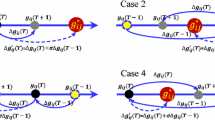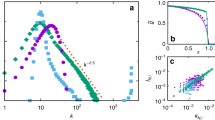Abstract
The complex network structure of biological brains is obtained through the developmental processes. Type and complexity of network structure directly reflect the ability of the network to deal with information processing. In this paper, we propose a developmental method for creating recurrent spiking neural networks based on genetic regulatory network model. This research investigates the developmental process of spiking neural networks, and analyzes the network structure in the different parameter settings, such as the number of regulatory nodes, the weights scale of genetic networks, and the developmental scale. The experimental results show that the developmental spiking neural networks have the similar topological characteristics as biological networks, namely scale-free and small-world properties.
Access this chapter
Tax calculation will be finalised at checkout
Purchases are for personal use only
Similar content being viewed by others
References
Kasabov, N.K.: NeuCube: a spiking neural network architecture for mapping, learning and understanding of spatio-temporal brain data. Neural Netw. 52, 62–76 (2014)
Diehl, P.U., Zarrella, G., Cassidy, A., et al.: Conversion of artificial recurrent neural networks to spiking neural networks for low-power neuromorphic hardware. In: Proceedings of the IEEE International Conference on Rebooting Computing, pp. 1–8 (2016)
Kitano, H.: Designing neural networks using genetic algorithms with graph generation system. Complex Syst. 4(4), 461–476 (1990)
Homma, N., Aoki, T. Higuchi, T.: Evolutionary graph generation system with transmigration capability for arithmetic circuit design. In: Proceedings of the 2001 IEEE International Symposium on Circuits and Systems, vol. 5, pp. 171–174 (2001)
Gruau F.: Neural network synthesis using cellular encoding and the genetic algorithm. Ph.D. thesis, Université Claude Bernard-Lyon (1994)
Longabaugh, W.J., Davidson, E.H., Bolouri, H.: Computational representation of developmental genetic regulatory networks. Dev. Biol. 283, 1–16 (2005)
Martín, M., Organista, M.F., de Celis, J.F.: Structure of developmental gene regulatory networks from the perspective of cell fate-determining genes. Transcription 7(1), 32–37 (2016)
Lones, M.A.: Computing with Artificial Gene Regulatory Networks: Evolutionary Algorithms in Gene Regulatory Network Research. Wiley, Hoboken (2016)
Ahmadizar, F., Soltanian, K., AkhlaghianTab, F., et al.: Artificial neural network development by means of a novel combination of grammatical evolution and genetic algorithm. Eng. Appl. Artif. Intell. 39, 1–13 (2015)
Federici, D.: A regenerating spiking neural network. Neural Netw. Off. J. Int. Neural Netw. Soc. 18(5–6), 746–754 (2005)
Weaver, D.C., Workman, C.T., Stormo, G.D.: Modeling regulatory networks with weight matrices. In: Proceedings of Pacific Symposium on Biocomputing, vol. 4, pp. 112–123 (1999)
Fazekas, I, Porvázsnyik, B.: Scale-free property for degrees and weights in a preferential attachment random graph model. J. Probab. Stat. (2013). Article ID 707960
Suzuki, T., Okazawa, M., Ohkura, K.: Small-world property evaluated by exchanging network topology. Int. J. Mod. Phys. C 26(11), 1550122 (2015)
Mehlhorn, H., Schreiber, F.: Small-world property. In: Dubitzky, W., Wolkenhauer, O., Cho, K.-H., Yokota, H. (eds.) Encyclopedia of Systems Biology, pp. 1957–1959. Springer, New York (2013). doi:10.1007/978-1-4419-9863-7_2
Acknowledgement
This research is supported by the National Natural Science Foundation of China under Grant No. 61165002, and the Natural Science Foundation of Gansu Province of China under Grant No. 1506RJZA127, and the Scientific Research Project of Universities of Gansu Province under Grant No. 2015A-013.
Author information
Authors and Affiliations
Corresponding author
Editor information
Editors and Affiliations
Rights and permissions
Copyright information
© 2017 Springer International Publishing AG
About this paper
Cite this paper
Lin, X., Li, Y., Zhao, J. (2017). Topological Structure Analysis of Developmental Spiking Neural Networks. In: Huang, DS., Bevilacqua, V., Premaratne, P., Gupta, P. (eds) Intelligent Computing Theories and Application. ICIC 2017. Lecture Notes in Computer Science(), vol 10361. Springer, Cham. https://doi.org/10.1007/978-3-319-63309-1_9
Download citation
DOI: https://doi.org/10.1007/978-3-319-63309-1_9
Published:
Publisher Name: Springer, Cham
Print ISBN: 978-3-319-63308-4
Online ISBN: 978-3-319-63309-1
eBook Packages: Computer ScienceComputer Science (R0)




